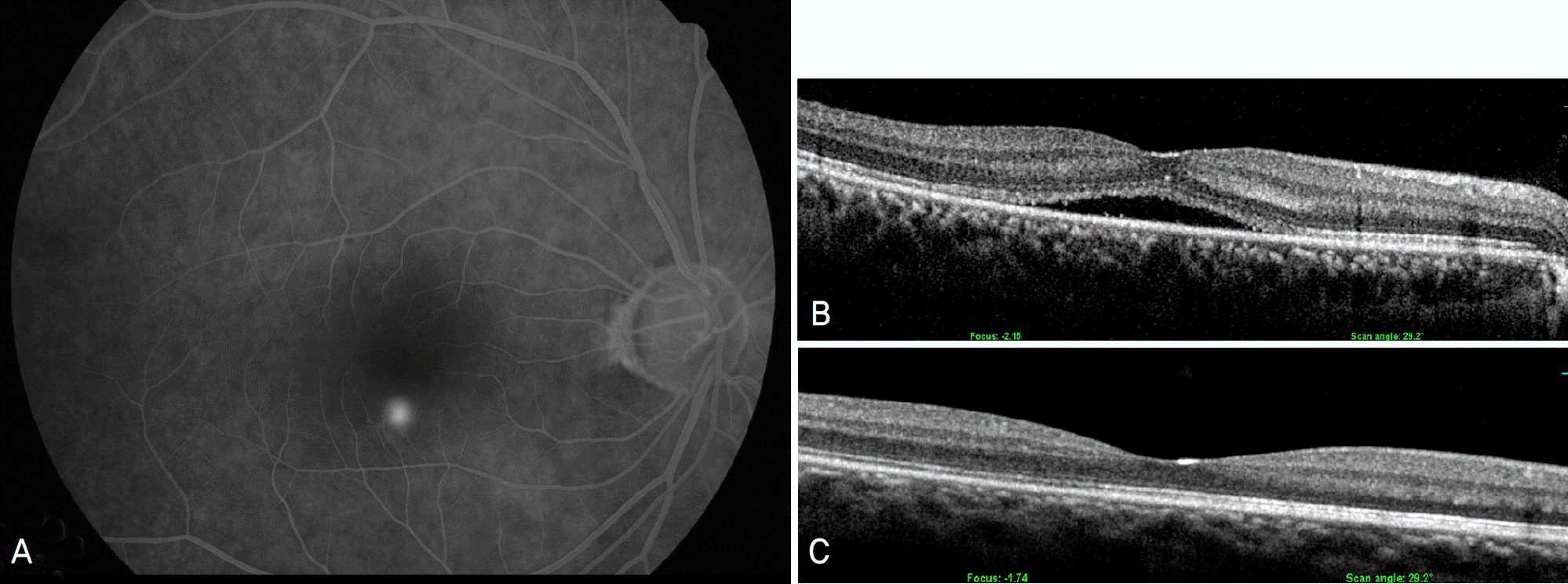Abstract
Purpose
To determine whether intravitreal bevacizumab is effective for the treatment of central serous chorioretinopathy.
Methods
We retrospectively examined 42 eyes after intravitreal bevacizumab (1.25 mg) injection for central serous chorioretinopathy. After 1 month, improvement of vision and change in sensory retinal detachment were evaluated with a fundus examination and optical coherence tomography.
Results
The mean duration of symptoms was 3.9±2.31 months. After intravitreal bevacizumab injection, mean best corrected visual acuity improved from 0.53±0.31 to 0.72±0.29 at 1 month. In addition, neurosensory retinal detachment disappeared in 32 patients (76.2%). Five patients among ten who did not show improvement of neurosensory retinal detachment underwent reinjection of bevaczumab, and three of those reinjected showed the resolution of neurosensory retinal detachment at another 1 month. No improvement was seen among the patients who did not undergo reinjection.
Go to : 
References
1. Gass JD. Pathogenesis of disciform detachment of the neu-ro-epithelium. II. Idiopathic central serous chorioretinopathy. Am J Ophthalmol. 1967; 63:587–615.
2. Yannuzzi LA, Gitter KA, Schatz H. The macula: a comprehensive text and atlas, 2nd ed. Baltimore: William&Wilkins,. 1982; 145–65.
3. Gilbert CM, Owens SL, Smith PD, Fine SL. Long-term follow up of central serous choriortinopathy. Br J Ophthalmol. 1984; 68:815–20.
4. Wang MS, Sander B, Larsen M. Retinal atrophy in idiopathic central serous chorioretinopathy. Am J Ophthalmol. 2002; 133:787–93.
5. Idia T, Yannuzzi LA, Spaide RF, et al. Cystoid macular degeneration in chronic central serous chorioretinopathy. Retina. 2003; 23:1–7.

6. Leaver P, Williams C. Argon Laser photocoagulation in the treatment of central serous retinopathy. Br J Ophthalmol. 1979; 63:674–7.

7. Novak MA, Singerman LJ, Rice TA. Krypton and argon laser photo-coagulation for central serous chorioretinopathy. Retina. 1987; 7:162–9.

8. Chan WM, Lam DS, Lai TY, et al. Choroidal vascular remodelling in central serous chorioretinopathy after indocyanine green guided photodynamic therapy with verteporfin: a novel treatment at the primary disease level. Br J Ophthalmol. 2003; 87:1453–8.

9. Battaglia Parodi M, Da Pozzo S, Ravalico G. Photodynamic therapy in chronic central serous chorioretinopathy. Retina. 2003; 23:235–7.

10. Canakis C, Livir-Rallatos C, Panayiotis Z, et al. Ocular photodynamic therapy for serous macular detachment in the diffuse retinal pigment epitheliopathy variant of idiopathic central serous chorioretinopathy. Am J Ophthalmol. 2003; 136:750–2.

11. Cardillo Piccolino F, Eandi CM, Ventre L, et al. Photodynamic therapy for chronic central serous chorioretinopathy. Retina. 2003; 23:752–63.

12. Yannuzzi LA, Slakter JS, Gross NE, et al. Indocyanine green angiography guided photodynamic therapy for treatment of chronic central serous chorioretinopathy: a pilot study. Retina. 2003; 23:288–98.
13. Taban M, Boyer DS, Thomas EL, et al. Chronic central serous chorioretinopathy: photodynamic therapy. Am J Ophthalmol. 2004; 137:1073–80.

14. Chung SE, Kang JH, Kang SW. Chronic central serous chorioretinopathy: Photodynamic Therapy. J Korean Ophthalmol Soc. 2007; 48:279–84.
15. Song MH, Lee PY, Kim KS, Lee WK. The effect of photodynamic therapy in chronic central serous chorioretinopathy. J Korean Ophthalmol Soc. 2007; 48:1048–58.

16. Kim JL, Kim HW, Yoon IH. Photodynamic therapy with verteporfin for short time for chronic central serous chorioretinopathy. J Korean Ophthalmol Soc. 2008; 49:1078–86.
17. Kim M, Chung H. The result of photodynamic therapy in chronic central serous chorioretinopathy. J Korean Ophthalmol Soc. 2009; 50:1035–43.

18. Tzekov R, Lin T, Zhang KM, et al. Ocular changes after photodynamic therapy. Invest Ophthalmol Vis Sci. 2006; 47:377–85.

19. Torres-Soriano ME, García-Aguirre G, Kon-Jara V, et al. A pilot study of intravitreal bevacizumab for the treatment of central serous chorioretinopathy (case reports). Graefes Arch Clin Exp Ophthalmol. 2008; 246:1235–9.

20. Huang WC, Chen WL, Tsai YY, et al. Intravitreal bevacizumab for treatment of chronic central serous chorioretinopathy. Eye. 2009; 23:488–9.

21. Seong HK, Bae JH, Kim ES, et al. Intravitreal bevacizumab to treat acute central serous chorioretinopathy:short-term effect. Ophthalmologica. 2009; 223:343–7.
22. Bouzas EA, Karadimas P, Pournaras CJ. Central serous chorioretinopathy and glucocorticoids. Surv Ophthalmol. 2002; 47:431–48.

23. Spitznas M. Pathogenesis of central serous retinopathy: a new work-ing hypothesis. Graefes Arch Clin Exp Ophthalmol. 1986; 224:321–4.

24. Marmor MF. New hypotheses on the pathogenesis and treatment of serous retinal detachment. Graefes Arch Clin Exp Ophthalmol. 1988; 226:548–52.

25. Lafaut BA, Salati C, Priem H, De Laey JJ. Indocyanine green angiography is of value for the diagnosis of chronic serous chorioretinopathy in elderly patients. Graefes Arch Clin Exp Ophthalmol. 1998; 236:513–21.
26. Piccolino FC, Borgia L. Central serous chorioretinopathy and indocyanine green angiography. Retina. 1994; 14:231–42.

27. Bandello F, Virgili G, Lanzetta P, et al. ICG angiography and retinal pigment epithelial decompensation. J Fr Ophtalmol. 2001; 24:448–51.
28. Ficker L, Vafidis G, While A, Leaver P. Long-term follow-up of a prospective trial of argon laser photocoagulation in the treatment of central serous chorioretinopathy. Br J Ophthalmol. 1988; 72:829–34.
29. Loo RH, Scott IU, Flynn HW, et al. Factors associated with reduced visual acuity during long-term follow-up of patients with idiopathic central serous chorioretinopathy. Retina. 2002; 22:19–24.

30. Khosla PK, Rana SS, Tewari HK, et al. Evaluation of visual function following argon laser photocoagulation in central serous chorioretinopathy. Ophthalmic Surg Lasers. 1997; 28:693–7.
31. Schatz H, Yannuzzi LA, Gitter KA. Subretinal neovascular membrane following argon laser photocoagulation treatment for central serous choriodopathy: complication or misdiagnosis? Trans Am Acad Ophthalmol Otolaryn. 1977; 83:893–906.
32. Costa RA, Scapucin L, Moraes NS, et al. Indocyanine greenmediated photothrombosis as a new technique of treatment for persistent central serous chorioretinopathy. Curr Eye Res. 2002; 25:287–97.

33. Olivier S, Harissi-Dagher M, Sebag M. Photodynamic therapy for chronic serous detachment ofthe retinal pigment epithelium in a young patient. Can J Ophthalmol. 2005; 40:214–6.
34. Chan WM, Lai TY, Lai RY, et al. Safety enhanced photodynamic therapy for chronic central serous chorioretinopathy: one-year results of a prospective study. Retina. 2008; 28:85–93.
Go to : 
 | Figure 1.(A) Fluorescein angiograph of a patient with central serous chorioretinopathy showing a focal leakage. (B) Optical coherence tomograph (OCT) before treatment showing subfoveal neurosensory retinal detachment. (C) OCT showing resolution of neurosensory retinal detachment after intravitreal bevacizumab injection. |




 PDF
PDF ePub
ePub Citation
Citation Print
Print


 XML Download
XML Download